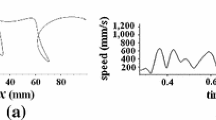Abstract
In pattern recognition, a diversification of characters is necessary for learning, which is like neural network learning. The artificial diversification of characters has been suggested as one means of collecting a variety of characters. Accordingly, we show that a computational handwriting model can be applied to the diversification of characters. It is thought that characters diversified by the model can be used as a database of character images for learning. Wada & Kawato’s handwriting model [11] is based on an optimal principle and the feature space of the characters includes sets of via-points extracted from actual handwritten characters. Therefore, if the via-point information is changed, diversiform characters can be generated using the handwriting model. In this paper, we propose a method for generating a diversification of characters by changing via-point information based on a genetic algorithm.
Preview
Unable to display preview. Download preview PDF.
Similar content being viewed by others
References
S. Edelman and T. Flash. A model of handwriting. Biological Cybernetics, 57:25–36, (1987).
T. Flash and N. Hogan. The coordination of arm movements: An experimentally confirmed mathematical model. Journal of Neuroscience, 5:1688–1703, (1985).
H. Hase, M. Yoneda, M. Sakai, and J. Yoshida. Evaluation of handprinting variation of characters using variation entropy. IEICE, J-71-D(6):1048–1056, (1988). (in Japanese).
J. M. Hollerbach. An oscillation theory of handwriting. Biological Cybernetics, 39:139–156, (1981).
D. Marr. Vision. Freeman, W.H. and Company, New York, (1982).
P. Morasso and F. A. Mussa Ivaldi. Trajectory formation and handwriting: A computational model. Biological Cybernetics, 45:131–142, (1982).
E. Nakano, H. Imamizu, R. Osu, Y. Uno, H. Gomi, T. Yoshioka, and M. Kawato. Quantitative examinations of internal representations for arm trajectory planning: minimum commanded torque change model. Journal of Neurophysiology, 81(5):2140–2155, (1999).
R. Plamondon and W. Guerfali. The generation of handwriting with delta-lognormal synergies. Biological Cybernetics, 78:119–132, (1998).
Y. Uno, M. Kawato, and R. Suzuki. Formation and control of optimal trajectory in human multijoint arm movement-minimum torque change model. Biological Cybernetics, 61:89–101, (1989).
Y. Wada and M. Kawato. A neural network model for arm trajectory formation using forward inverse dynamics model. Neural Networks, 6:919–9320, (1993).
Y. Wada and M. Kawato. Theory for cursive handwriting based on the minimization principle. Biological Cybernetics, 73:3–13, (1995).
Author information
Authors and Affiliations
Editor information
Editors and Affiliations
Rights and permissions
Copyright information
© 2001 Springer-Verlag Berlin Heidelberg
About this paper
Cite this paper
Wada, Y., Ohkawa, K., Sumita, K. (2001). Generation of Diversiform Characters Using a Computational Handwriting Model and a Genetic Algorithm. In: Dorffner, G., Bischof, H., Hornik, K. (eds) Artificial Neural Networks — ICANN 2001. ICANN 2001. Lecture Notes in Computer Science, vol 2130. Springer, Berlin, Heidelberg. https://doi.org/10.1007/3-540-44668-0_170
Download citation
DOI: https://doi.org/10.1007/3-540-44668-0_170
Published:
Publisher Name: Springer, Berlin, Heidelberg
Print ISBN: 978-3-540-42486-4
Online ISBN: 978-3-540-44668-2
eBook Packages: Springer Book Archive




